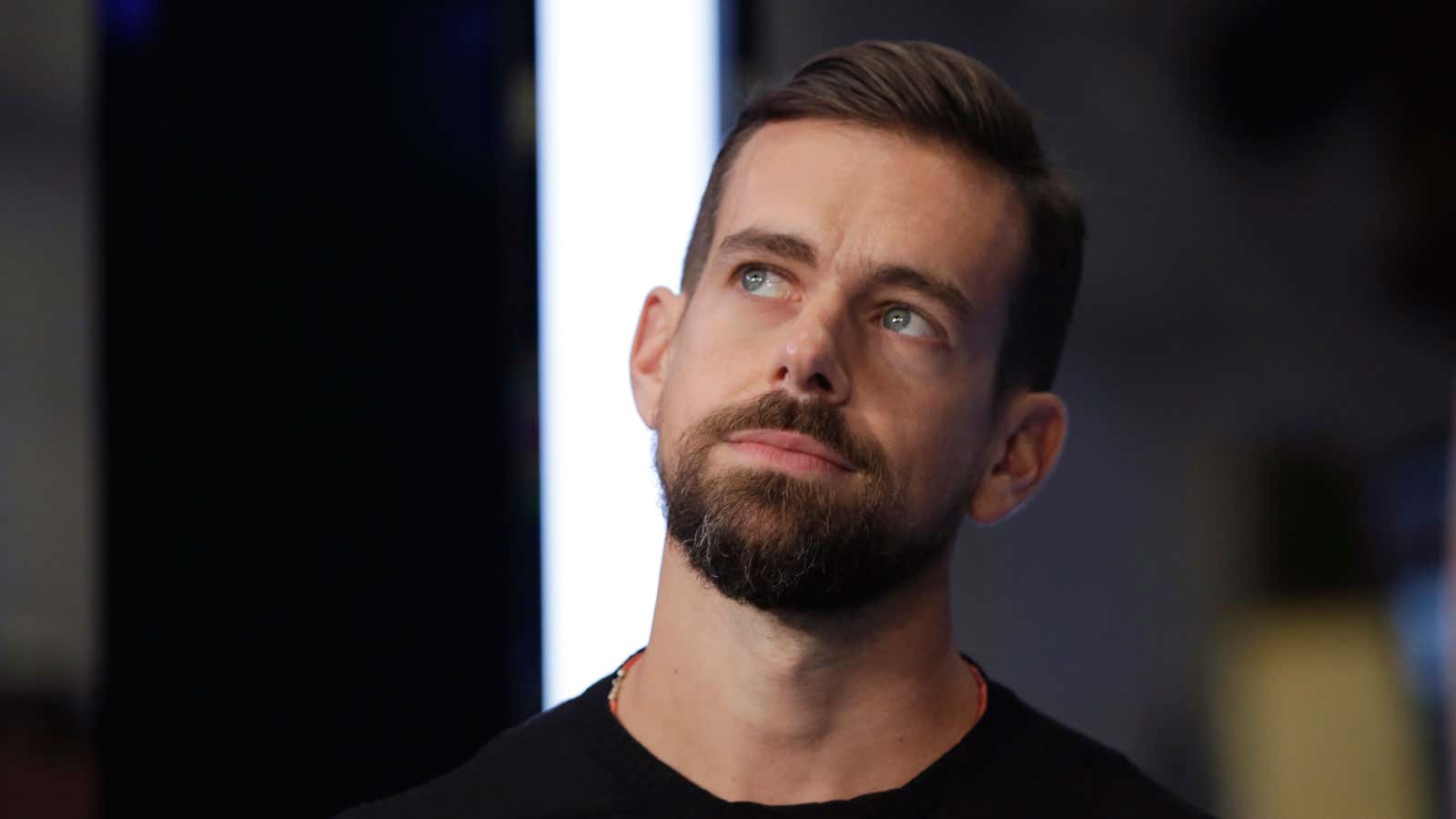It’s been almost a year since Dick Costolo announced he was stepping down as Twitter’s CEO, putting Jack Dorsey, the social network’s cofounder, in the top spot again—first on an interim basis, and then permanently.
Dorsey’s efforts to turn around Twitter apparently haven’t impressed investors. The tech firm’s stock price, bouncing back from yet another new low, closed at $15.05 on May 27, less than half of what it was a year ago. Just this week, the firm MoffettNathanson downgraded Twitter’s stock to sell, arguing that “hope is not a strategy.” It’s clear: Investors are running out of patience.
Shareholders had high hopes for Dorsey, who was appointed Twitter’s permanent CEO after more than 100 days of deliberation by the board. He came into the role with a mandate to make the fledging social network, which has struggled to attract new users, a mainstream service.
His turnaround plan started with Moments, a highly anticipated feature launched the day after Dorsey was appointed as Twitter’s permanent CEO last October. The Moments tab, which packaged tweets into collections users could follow, was supposed to make the service less confusing to newcomers who might not know which accounts to follow or hashtags to search. Twitter’s rapid-fire, chronological stream can be intimidating to those unfamiliar with it, and the hope was that Moments would convey its value in surfacing live conversations around topics they care about.
Yet for all its fanfare, it’s unclear how successful Moments actually is. User growth on Twitter remains painfully slow—in fact, the company actually reported negative growth in the quarter it debuted Moments. On Android, where Twitter experiments with new features, a beta release removed the tab entirely from the app. (Update: A Twitter rep says the removal of Moments was “just a bug.”) And tellingly, two of the key people behind Moments recently left the company. Business Insider reported on May 27 that product manager Madhu Muthukumar recently joined Facebook’s virtual reality division, Oculus, while director of engineering, Vijay Pandurangan, departed in March. “Twitter continues to invest heavily in Moments,” said a Twitter spokeswoman, who confirmed their departures. “We have a strong team in place with exciting updates ahead.”
There are signs of further turmoil within Twitter. According to a May 25 BuzzFeed report, the company’s commerce team is a shell of what it was. Development of its “buy” button, which lets users purchase products directly from tweets, and product pages has stopped, reports BuzzFeed, and many members of the team have been shuffled to other products. Buy buttons can still be found on the site, but no new technology has been built into the product, a source familiar with the situation tells Quartz.
There’s been little indication people want to purchase products on social media, especially on Twitter, a platform better suited for breaking news and conversations around live events. It’s estimated that social channels drove just 1.8% of online sales over the last holiday season in the US.
In an email, Twitter said it decided ”to INCREASE our investment in commerce by moving fully into Dynamic Product Ads,” promotional tweets served to users based on their browsing history. “The bottom line is [Dynamic Product Ads] work for advertisers and we will continue to invest in that product.” During the company’s first quarter earnings call on April 26, chief operating officer Adam Bain said these ads led to a 100% lift in the rates people click on advertisement links and purchase products. But that quarter was also Twitter’s slowest in terms of revenue growth since it went public in 2013.
In another attempt to mainstream Twitter, the company recently announced a number of sweeping changes easing up on its hallmark 140-character limit. Twitter plans to revise how characters are counted in certain situations and alter the syntax structure for tweet replies. For a service that’s been criticized as too technical, it was yet another list of rules for users to remember. People who were already active on the service admitted to being confused, and the changes even tripped up some reporters dedicated to the social media beat, as evidenced by corrections in BuzzFeed and the New York Times.
Turnarounds of flailing tech companies don’t come easy, but Twitter has floundered since its IPO, as social media platforms like Facebook and Snapchat experienced robust growth. Twitter has had years to prove itself to Wall Street, and impatient investors are now looking for real, tangible results. Under Dorsey, Twitter’s been operating on a clear mission to simplify the service, but there have been few indications so far that the company is successfully executing on that goal.
